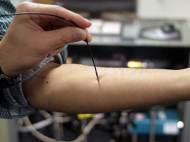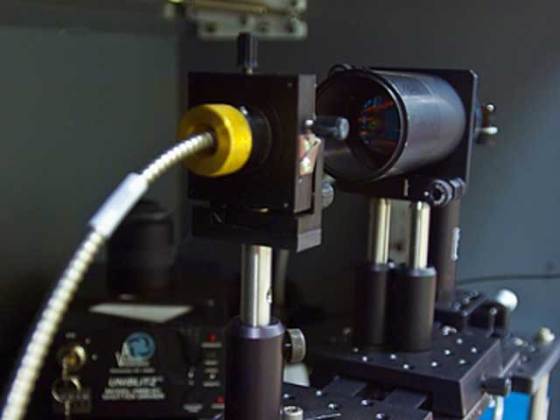MIT’s device allows a non-invasive way to check glucose levels
 People with diabetes must keep a careful eye on their blood glucose levels, because too much sugar can damage organs, while too little deprives the body of necessary fuel. Most patients must prick their fingers several times a day to draw blood for testing. In one of our previous articles we wrote about hydrogel lenses that could alert the diabetics to eat or take insulin, and in this article we’re going to write about another noninvasive way to measure blood glucose levels by using light which is developed by researchers at MIT’s Spectroscopy Laboratory.
People with diabetes must keep a careful eye on their blood glucose levels, because too much sugar can damage organs, while too little deprives the body of necessary fuel. Most patients must prick their fingers several times a day to draw blood for testing. In one of our previous articles we wrote about hydrogel lenses that could alert the diabetics to eat or take insulin, and in this article we’re going to write about another noninvasive way to measure blood glucose levels by using light which is developed by researchers at MIT’s Spectroscopy Laboratory.
First envisioned by Michael Feld, the late MIT professor of physics and former director of the Spectroscopy Laboratory, the technique uses Raman spectroscopy, a method that identifies chemical compounds based on the frequency of vibrations of the bonds holding the molecule together. The technique can reveal glucose levels by simply scanning a patient’s arm or finger with near-infrared light, eliminating the need to draw blood.
Spectroscopy Lab graduate students Ishan Barman and Chae-Ryon Kong are developing a small Raman spectroscopy machine (about the size of a laptop computer) that could be used in a doctor’s office or a patient’s home.
Researchers in the Spectroscopy Lab have been developing this technology for about 15 years. One of the major obstacles they have faced is that near-infrared light penetrates only about half a millimeter below the skin, so it measures the amount of glucose in the fluid that bathes skin cells (known as interstitial fluid), not the amount in the blood. To overcome this, the team came up with an algorithm that relates the two concentrations, allowing them to predict blood glucose levels from the glucose concentration in interstitial fluid.
However, this calibration becomes more difficult immediately after the patient eats or drinks something sugary, because blood glucose soars rapidly, while it takes five to 10 minutes to see a corresponding surge in the interstitial fluid glucose levels. Therefore, interstitial fluid measurements do not give an accurate picture of what’s happening in the bloodstream.
To address that lag time, Barman and Kong developed a new calibration method, called Dynamic Concentration Correction (DCC), which incorporates the rate at which glucose diffuses from the blood into the interstitial fluid. In a study of 10 healthy volunteers, the researchers used DCC-calibrated Raman spectroscopy to significantly boost the accuracy of blood glucose measurements — an average improvement of 15 percent, and up to 30 percent in some subjects.
Barman and Kong plan to launch a clinical study to test the DCC algorithm in healthy volunteers this fall. They believe that the smaller machine they are developing should substantially drive down costs by miniaturizing and reducing the complexity of the instrument. For more information, check their research paper published in Analytical Chemistry: “Accurate Spectroscopic Calibration for Noninvasive Glucose Monitoring by Modeling the Physiological Glucose Dynamics“.










Leave your response!